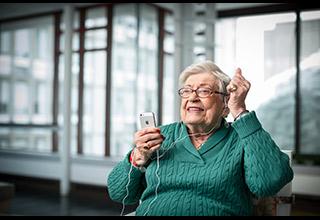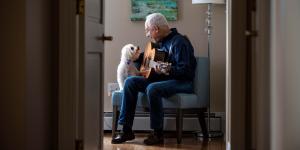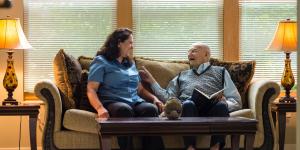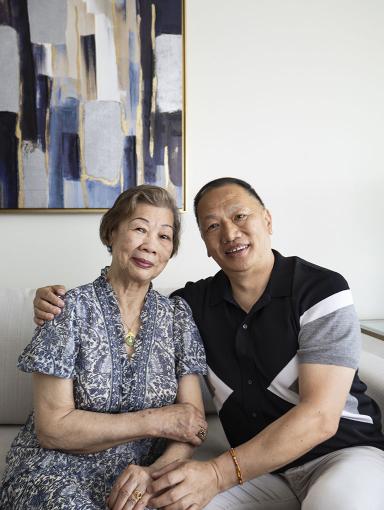Art in the Environment Promotes Healing and Connection for Frail Seniors
Newly Remodeled Household at Hebrew Rehabilitation Center Connects Artists and Patients
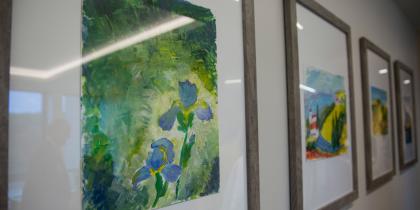
In my time at HSL, I have come to value the power of art in our patients’ and residents’ lives. Science backs this up: For example, a recent study at The Museum of Modern Art and The Metropolitan Museum of Art in New York showed that Alzheimer’s patients had fewer emotional problems the week after a museum visit, as well as an improvement in mood, self-esteem and greater sense of social support.
We see these results and more at Hebrew Rehabilitation Center in our expressive therapy programs, in our art classes, and in our Daniels Art Gallery, which features rotating art exhibits for patients and visitors to enjoy. Moreover, many of our patients and residents are accomplished artists, and their work is displayed throughout our campuses.
So, when I was asked to curate the art for the Deanna and Sidney Wolk Family Pavilion, a newly remodeled household at Hebrew Rehabilitation Center in Boston, I was intrigued by the challenge. How could I use art to realize HSL’s person-centered approach to patient care? How could I create as many ways as possible to engage each patient and bring joy to their lives?
To that end, I carefully selected artwork that would enhance the mood and purpose of each room. In areas meant to soothe and relax, I chose calming colors and works involving less visual complexity. In social rooms and eating areas, I opted for works that would energize and engage the residents and stimulate conversation. Artwork is even used in patient rooms to hide medical equipment, making the space feel more home-like.
As manager of the Daniels Art Gallery, I decided to work mostly with artists I know whose work resonated with the patients the most. About 75 percent of the artwork in the new household was generously donated to HSL by these artists in response to the overwhelming sense of connection they felt while exhibiting their work in the gallery. Many other pieces were created by patients and residents.
The first pieces I chose were for the living room, a space for relaxing by the fire with friends or reading a favorite book. The paintings were created by Ruth LaGue, a landscape painter who grew up in Alaska. The highly textured layers she develops create a stimulating, yet peaceful version of an Alaskan landscape. At first glance you may not read it as a landscape but the subtlety just adds to the interest of the art, creating room for conversation and interpretation. Ruth’s paintings create a sense of conviviality and home, essential aspects of a patient-centered environment.
Like the living room, the art room strongly inspired me to pursue a painting from a known artist: Rachel Wilcox. The historic Boston theater district is a landmark many of our patients remember fondly. This room is designed to inspire patients to make artwork of their own. I have no doubt that Rachel’s Paramount Theater painting will fill our patient-artists with memories of special times with loved ones.
Perhaps the most meaningful artwork in the new household was created by one of our talented patients as part of our art therapy program. They are done in acrylics and some of them, for example, a replica of Van Gogh’s haystacks, are master copies. That is when an artist studies the work of a well-known artist to fine tune their own skills. It brings great joy to this patient – and all our patients – to see her artwork featured alongside professional artists.
Through the generosity of our donors as well as the innovation and hard work of the staff, we have incorporated multi-sensory healing elements into the architecture of our new household, including the placement of beautiful art from our collection.
In this way, HSL is bringing the art to our patients, not just for an afternoon, but 365 days a year.
The new household on the campus of Hebrew Rehabilitation Center in Boston opened in August 2018. The project is being supported by generous leadership gifts from Deanna and Sidney Wolk, the Theodore W. & Evelyn G. Berenson Charitable Foundation, Helaine Berenson Allen, and the Amelia Peabody Charitable Fund. Continued renovations on the campus will be funded through additional philanthropy.
Blog Topics
How Can HSL Help?
Long-Term Chronic Care
Hebrew Rehabilitation Center provides person-centered extended medical care in a homelike setting for patients with chronic illness. As a licensed long-term chronic care hospital, we provide higher-level, more comprehensive medical care to older adults than a traditional nursing home.
